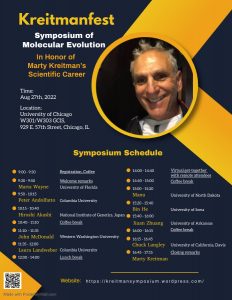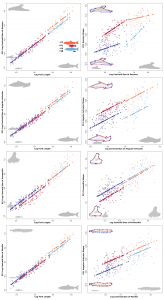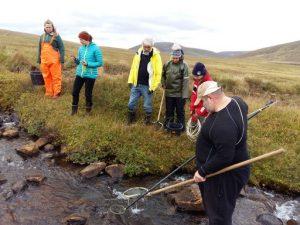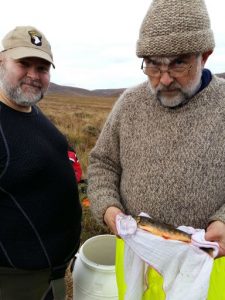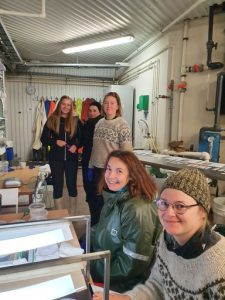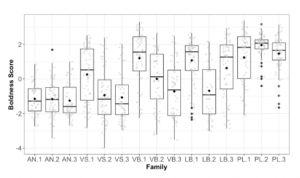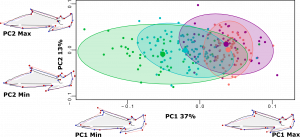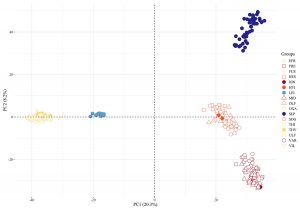Switch language:
-
Pistlar og atburðir
- Contributions to ICEBIO25
- (Icelandic) Fjórðungi bregður til nafns: af uppnefndum genum og sérvisku erfðafræðinga
- Nicinthya Pajanissamy was a great and wonderful human and student
- Variation of tooth traits in ecologically specialized and sympatric morphs vs 2.
- Whole genome sequencing reveals how plasticity and genetic differentiation underlie sympatric morphs of Arctic charr.
The prey availability and diet of juvenile Atlantic salmon (Salmo salar L.) in low-productivity rivers in northern Europe
The prey availability and diet of juvenile Atlantic salmon (Salmo salar L.) in low-productivity rivers in northern Europe
accepted for publication in the Journal of Fish Biology. http://doi.org/10.1111/jfb.15757
Authors:
Sum Yi Lai1,2, Arnar Pálsson2, Guðni Guðbergsson1, Ingi Rúnar Jónsson1, Jón S. Ólafsson1, Hlynur Bárðarson1
1. Marine and Freshwater Research Institute, Hafnarfjördur, Iceland
2. University of Iceland, Reykjavík, Iceland
Corresponding author: Name: Sum Yi Lai Address: Marine and Freshwater Research Institute, Fornubúdir 5, 220 Hafnarfjördur, Iceland,
Email: sammi.lai@hafogvatn.is
Abstract:
The availability of resources varies across a species distributional range, and a low productivity area can make a species more vulnerable. We investigated the invertebrate composition and prey choice of juvenile Atlantic salmon (Salmo salar L.) in low productivity rivers at Northeast Iceland, which is one of the species´ most northerly distributions. By sampling benthic and drift invertebrate populations, we found that prey availability was similar within and between rivers. Gut content samples showed that the main prey choice for juvenile S. salar was the Chironomidae. The type of food items consumed varied across different weight groups of S. salar, with smaller juveniles having more diverse diet. S. salar did not have a selection preference for chironomids, which indicate that they were eating the highly available prey in their environment, rather than hunting high biomass items such as terrestrial invertebrates and large Dipterans. Estimates of dietary niche showed that S. salar in these low-productivity rivers relied on consuming what was most readily available, the chironomids, and that they must share resources with other salmonid species. This may be due to the low diversity of freshwater invertebrates (fewer prey options), whereas S. salar in nutrient-rich rivers could rely more on terrestrial invertebrates as an additional subsidy in their diet. In conclusion, with limited prey choices, juvenile S. salar in nutrient-poor rivers, especially in a biogeographically isolated region with low species diversity, may increase in vulnerability and decrease in adaptability to environmental change. Management methods that increase benthic prey abundance and diversity are recommended for conserving S. salar population in a nutrient-poor river
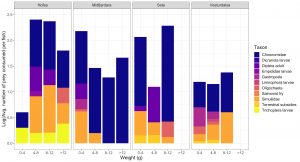
Log10 average number of prey items found in stomachs of juvenile Atlantic salmon (Salmo salar) was differed significantly across rivers (p<0.001) and by weight ranges (p<0.001).
The number of prey items consumed increased with weight (p<0.05). Log10 abundance also varies between taxonomic groups for all rivers (p<0.001) with abundances of Chironomidae higher in comparison.
Posted in Publications
Symposium of Molecular Evolution: In Honor of Marty Kreitman’s Scientific Career
It was at the Drosophila meeting in San Diego 10-14th of April 2002. I had arrived with my uncle Einar Arnason and his late wife Betty, after driving down from Passadena. In the ginormous reception ball room we snacked and drank, until Einar was bundled by a springly fellow with wired hair and manners. Marty Kreitman had arrived at the scene.
Drosophila Research Conference (drosophila-conf.org)
I had greatly admired his population genetic work, though it was the work Marty did with Misha Ludwig that particularly impressed me. The first did population genetics on the best characterized regulatory element at the time, the stripe 2 enhancer of the eve (even-skipped) gene of D. melanogaster, and then moved to functional studies, comparing the element between species. See for instance a very impressive paper on chimeras of D. melanogaster and D. pseudoobscura s2e enhancers.
Evidence for stabilizing selection in a eukaryotic enhancer element.
Nature. 2000 Feb 3;403(6769):564-7. doi: 10.1038/35000615.PMID: 10676967
To make a long story short, serendipity helped me make Marty´s acquaintance and a year later I started a postdoc with him and Misha at the University of Chicago. There we had three fun years doing population genetics on enhancers and analyzing gene expression in embryos.
Functional evolution of a cis-regulatory module. 2005. Ludwig MZ, Palsson A, Alekseeva E, Bergman CM, Nathan J, Kreitman M. PLoS Biology. 3(4):e93. (doi:10.1371/journal.pbio.0030093 PDF)
Canalization of segmentation and its evolution in Drosophila. 2007. Lott SE, Kreitman M, Palsson A, Alekseeva E, Ludwig MZ. Proc Natl Acad Sci U S A. 104(26):10926-31. (doi: 10.1073/pnas.0701359104 PDF)
Naturally Occurring Deletions of Hunchback Binding Sites in the Even-Skipped Stripe 3+7 Enhancer. 2014. Palsson A, Wesolowska N, Reynisdóttir S, Ludwig MZ, Kreitman M. PLoS ONE 9(5): e91924. doi:10.1371/journal.pone.0091924.
In the summer of 2022 former trainees and friends of Marty arranged a nice farewell symposium for him in Chicago. Thankfully I got to participate via zoom, and see some of the great people again.
Posted in Articles about science, Publications
(Icelandic) Diversity of bones - resubmission in progress
The manuscript got quite favorable replies.
https://www.biorxiv.org/content/10.1101/2023.02.17.528955v2
We are continuing uploading the figures to Figshare+ and code to Github.
And adjusting the figures with new colour-blind friendlier palette.
See for instance.
Posted in Publications
Variation in personality shaped by evolutionary history, genotype and developmental plasticity in response to feeding modalities in the Arctic charr
Variation in personality shaped by evolutionary history, genotype and developmental plasticity in response to feeding modalities in the Arctic charr
Published:13 December 2023 https://doi.org/10.1098/rspb.2023.2302
Originally submitted May 4th 2023.
Animal personality has been shown to be influenced by both genetic and environmental factors and shaped by natural selection. Currently, little is known about mechanisms influencing the development of personality traits. This study examines the extent to which personality development is genetically influenced and/or environmentally responsive (plastic). We also investigated the role of evolutionary history, assessing whether personality traits could be canalized along a genetic and ecological divergence gradient. We tested the plastic potential of boldness in juveniles of five Icelandic Arctic charr morphs (Salvelinus alpinus), including two pairs of sympatric morphs, displaying various degrees of genetic and ecological divergence from the ancestral anadromous charr, split between treatments mimicking benthic versus pelagic feeding modalities. We show that differences in mean boldness are mostly affected by genetics. While the benthic treatment led to bolder individuals overall, the environmental effect was rather weak, suggesting that boldness lies under strong genetic influence with reduced plastic potential. Finally, we found hints of differences by morphs in boldness canalization through reduced variance and plasticity, and higher consistency in boldness within morphs. These findings provide new insights on how behavioural development may impact adaptive diversification.
Posted in Publications
Variation in personality shaped by evolutionary history, genotype, and developmental plasticity
"Dear Dr DellingerI am pleased to inform you that your manuscript RSPB-2023-2302 entitled "Variation in personality shaped by evolutionary history, genotype, and developmental plasticity in response to feeding modalities in the Arctic charr" has been accepted for publication in Proceedings B."
Dellinger, Marion; Steele, Sarah; Sprockel, Evert; Philip, Joris; Pálsson, Arnar; Benhaïm, David.
Very welcome outcome. Congrats to Sarah Steele and Marion Dellinger who led the study.
Boldness in behavior varied substantially by morphs, and also by families in some of the morphs, though noticably least in Anadromous (left) and planktivorous charr from Þingvallavatn (right).
Posted in Publications
Diversity in the internal functional feeding elements of sympatric morphs of Arctic charr (Salvelinus alpinus)
Submission of Guðbjörgs manuscript to PLoS One, second version of M.S. available on bioRxiv.
Diversity in the internal functional feeding elements of sympatric morphs of Arctic charr (Salvelinus alpinus)
The diversity of functional feeding anatomy is particularly impressive in fishes and correlates with various interspecific ecological specializations. Intraspecific polymorphism can manifest in divergent feeding morphology and ecology, often along a benthic pelagic axis. Arctic charr (Salvelinus alpinus) is a freshwater salmonid known for morphological variation and sympatric polymorphism and in Lake Þingvallavatn, Iceland, four morphs of charr coexist that differ in preferred prey, behaviour, habitat use, and external feeding morphology. We studied variation in six upper and lower jaw bones in adults of these four morphs using geometric morphometrics and univariate statistics. We tested for allometric differences in bone size and shape among morphs, morph effects on bone size and shape, and divergence along the benthic-pelagic axis. We also examined the degree of integration between bone pairs. We found differences in bone size between pelagic and benthic morphs for two bones (dentary and premaxilla). There was clear bone shape divergence along a benthic pelagic axis in four bones (dentary, articular angular, premaxilla and maxilla), as well as allometric shape differences between morphs in the dentary. Notably for the dentary, morph explained more shape variation than bone size. Comparatively, benthic morphs possess a compact and taller dentary, with shorter dentary palate, consistent with visible (but less prominent) differences in external morphology. As these morphs emerged in the last 10,000 years, these results indicate rapid functional evolution of specific feeding structures in arctic charr. This sets the stage for studies of the genetics and development of rapid and parallel craniofacial evolution.
Posted in Publications
A total of 2,597 polymorphic loci from 317 individuals out of 555 originally analysed were retained after the stringent filtering steps outlined in Materials and Methods. These markers were used to address questions about the patterns of genetic differentiation between locations. We estimated population genetic parameters for each sampling site.
Plot of two principal components separates three clusters of landlocked brown trout, the Scottish reference group, and the anadromous populations. The percentage of the variance explained by these components is shown in parentheses. See ms for three letter code.
Posted in Publications

